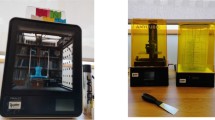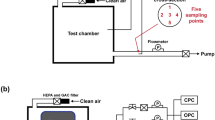Abstract
Recent studies have shown that high concentrations of ultrafine particles can be emitted during the 3D printing process. This study characterized the emissions from different filaments using common fused deposition modeling printers. It also assessed the effectiveness of a novel engineering control designed to capture emissions directly at the extruder head. Airborne particle and volatile organic compound concentrations were measured, and particle emission rates were calculated for several different 3D printer and filament combinations. Each printer and filament combination was tested inside a test chamber to measure overall emissions using the same print design for approximately 2 h. Emission rates ranged from 0.71 × 107 to 1400 × 107 particles/min, with particle geometric mean diameters ranging from 45.6 to 62.3 nm. To assess the effectiveness of a custom-designed engineering control, a 1-h print program using a MakerBot Replicator+ with Slate Gray Tough polylactic acid filament was employed. Emission rates and particle counts were evaluated both with and without the extruder head emission control installed. Use of the control showed a 98% reduction in ultrafine particle concentrations from an individual 3D printer evaluated in a test chamber. An assessment of the control in a simulated makerspace with 20 printers operating showed particle counts approached or exceeded 20,000 particles/cm3 without the engineering controls but remained at or below background levels (< 1000 particles/cm3) with the engineering controls in place. This study showed that a low-cost control could be added to existing 3D printers to significantly reduce emissions to the work environment.







Similar content being viewed by others
References
Adams S. (2018) Market insights: half million 3D printers sold in 2017 – on track for 100M sold in 2030. Available at https://3dprintingindustry.com/news/half-million-3d-printers-sold-2017-track-100m-sold-2030-131642/ (accessed 19 Feb 2019)
Azimi P, Zhao D, Pouzet C, Crain NE, Stephens B (2016) Emissions of ultrafine particles and volatile organic compounds from commercially available desktop three-dimensional printers with multiple filaments. Environ Sci Technol 50:1260–1268
Byeon JH, Kim J-W (2012) Particle emission from laser printers with different printing speeds. Atmos Environ 54:272–276
Byrley P, George BJ, Boyes WK, Rogers K (2019) Particle emissions from fused deposition modeling 3D printers: evaluation and meta-analysis. Sci Total Environ 655:395–407
Chan FL, House R, Kudla I, Lipszyc JC, Rajaram N, Tarlo SM (2010) Health survey of employees regularly using 3D printers. Occupational Med 68:211–214
Gümperlein I, Fischer E, Dietrich-Gümperlein G, Karrasch S, Nowak D, Jörres RA, Schierl R (2018) Acute health effects of desktop 3D printing (fused deposition modeling) using acrylonitrile butadiene styrene and polylactic acid materials: an experimental exposure study in human volunteers. Indoor Air 28:611–623
He C, Morawska L, Taplin L (2007) Particle emission characteristics of office printers. Environ Sci Technol 41:6039–6045
Kulkarni P, Baron PA, Willeke K (eds) (2011) Aerosol measurement: principles, techniques, and applications, 3rd edn. Wiley, New York
LeBouf RF, Stefaniak AB, Virji MA (2012) Validation of evacuated canisters for sampling volatile organic compounds in healthcare settings. J Environ Monit 14:977–983
Mendes L, Kangas A, Kukko K, Mølgaard B, Säämänen A, Kanerva T, Flores Ituarte I, Huhtiniemi M, Stockmann-Juvala H, Partanen J, Hämeri K, Eleftheriadis K, Viitanen A-K (2017) Characterization of emissions from a desktop 3D printer. J Ind Ecol 21:S94–S106
Scungio M, Vitanza T, Stabile L, Buonanno G, Morawska L (2017) Characterization of particle emission from laser printers. Sci Total Environ 586:623–630
Stefaniak AB, LeBouf RF, Duling MG, Yi J, Abukabda AB, McBride CR, Nurkiewicz TR (2017) Inhalation exposure to three-dimensional printer emissions stimulates acute hypertension and microvascular dysfunction. Toxicol Appl Pharmacol 335:1–5
Stefaniak AB, Johnson AR, du Preez S, Hammond DR, Wells JR, Ham JE, LeBouf RF, Menchaca KW, Martin SB Jr, Duling MG, Bowers LN, Knepp AK, Su FC, de Beer DJ, du Plessis JL (2018a) Evaluation of emissions and exposures at workplaces using desktop 3-dimensional printers. J Chem Health Saf 26:19–30
Stefaniak AB, Johnson AR, du Preez S, Hammond DR, Wells JR, Ham JE, LeBouf RF, Martin SB Jr, Duling MG, Bowers LN, Knepp AK, de Beer DJ, du Plessis JL (2018b) Insights into emissions and exposures from use of industrial-scale additive manufacturing machines, safety and health at work. Saf Health Work 10(2):229–236
Steinle P (2016) Characterization of emissions from a desktop 3D printer and indoor air measurements in office settings. J Occup Environ Hyg 13:121–132
Vance ME, Pegues V, Van Montfrans S, Leng W, Marr LC (2017) Aerosol emissions from fuse-deposition modeling 3D printers in a chamber and in real indoor environments. Environ Sci Technol 51:9516–9523
Zhang Q, Wong JPS, Davis AY, Black MS, Weber RJ (2017) Characterization of particle emissions from consumer fused deposition modeling 3D printers. Aerosol Sci Technol 51:1275–1286
Zontek TL, Ogle BR, Jankovic JT, Hollenbeck SM (2017) An exposure assessment of desktop 3D printing. J Chem Health Saf 24:15–25
Acknowledgments
The authors gratefully acknowledge the support of the NIOSH Nanotechnology Research Center cross-sector program (Paul A. Schulte and Charles L. Geraci, co-managers), Matt Duling for assistance in the study, and Ryan LeBouf for analysis of canister samples. Additionally, the authors would like to thank MakerBot for partnering with NIOSH to expand and share knowledge specific to the health and safety within this industry. The authors thank Len Zwack, PhD, and Aleks Stefaniak, PhD, CIH, for review of this manuscript.
Author information
Authors and Affiliations
Corresponding author
Ethics declarations
Conflict of interest
The authors declare that they have no conflict of interest.
Disclaimer
The findings and conclusions in this manuscript are those of the authors and do not necessarily represent the official position of the National Institute for Occupational Safety and Health, Centers for Disease Control and Prevention. Mention of any company or product does not constitute endorsement by the National Institute for Occupational Safety and Health, Centers for Disease Control and Prevention.
Additional information
Publisher’s note
Springer Nature remains neutral with regard to jurisdictional claims in published maps and institutional affiliations.
Rights and permissions
About this article
Cite this article
Dunn, K.L., Hammond, D., Menchaca, K. et al. Reducing ultrafine particulate emission from multiple 3D printers in an office environment using a prototype engineering control. J Nanopart Res 22, 112 (2020). https://doi.org/10.1007/s11051-020-04844-4
Received:
Accepted:
Published:
DOI: https://doi.org/10.1007/s11051-020-04844-4




